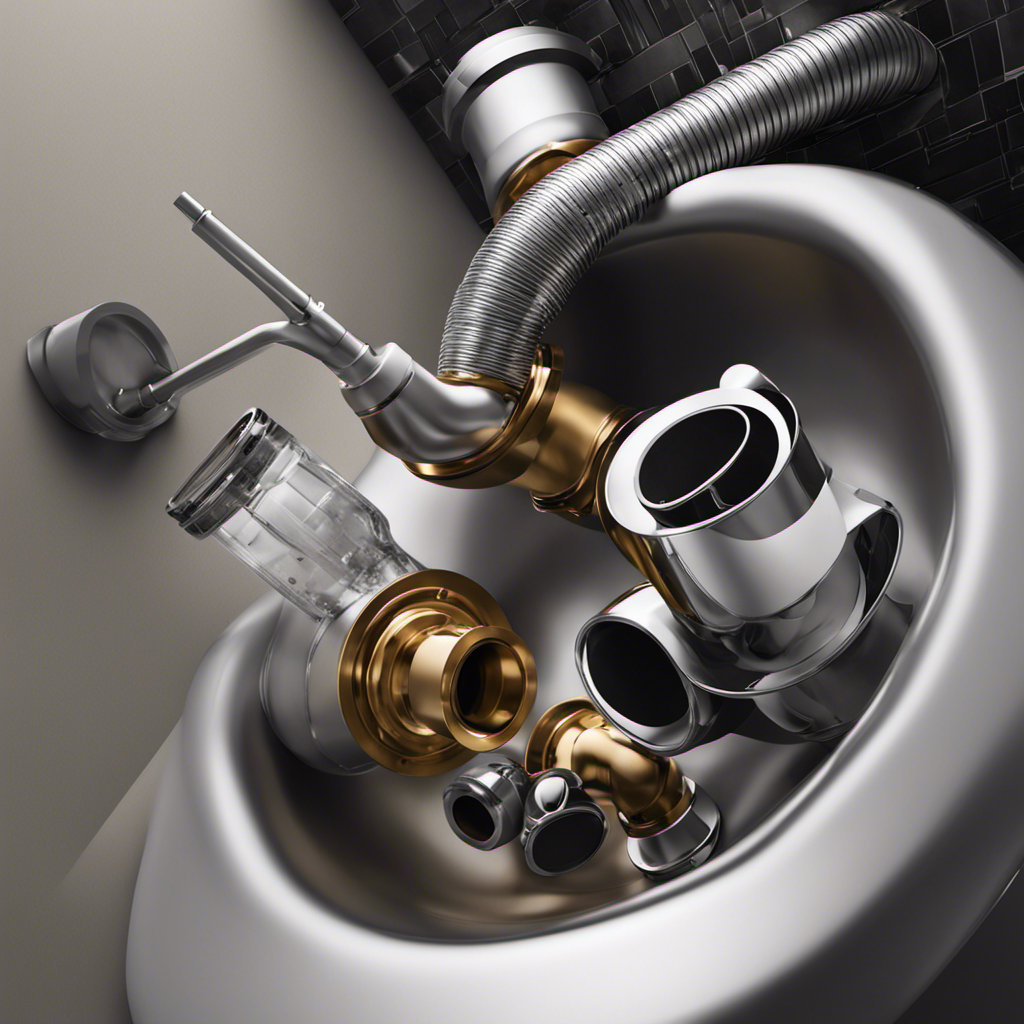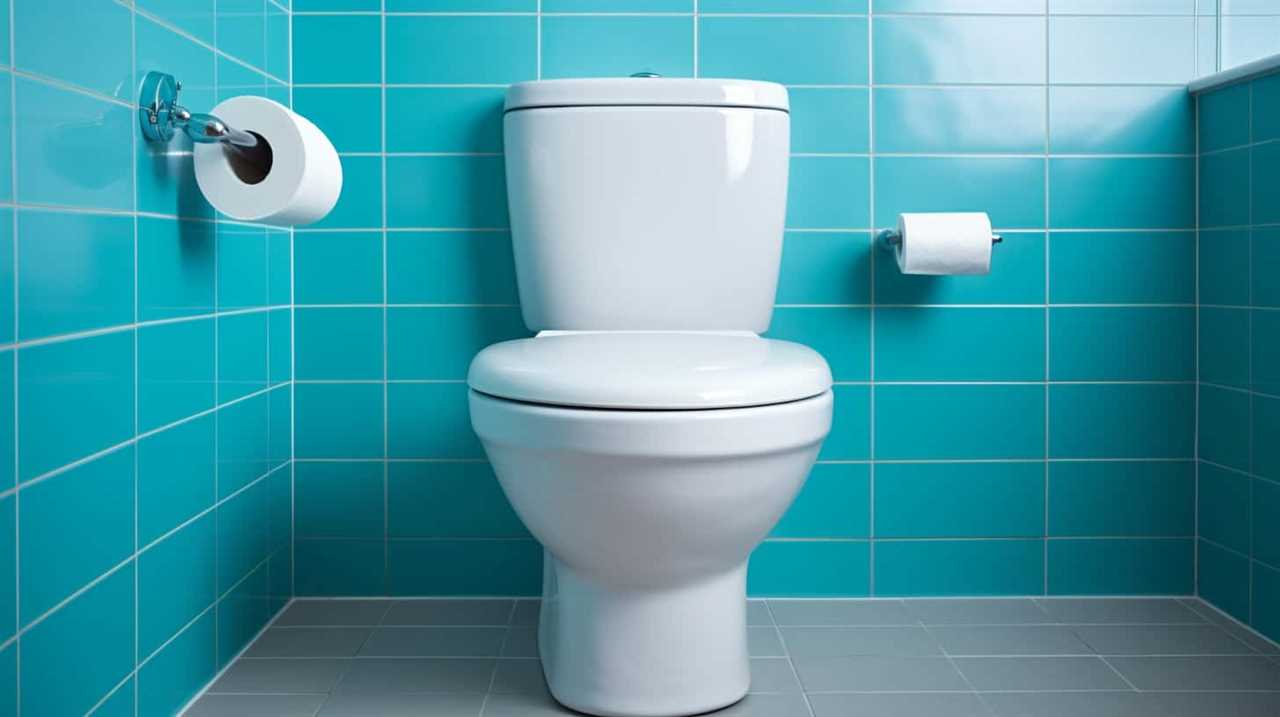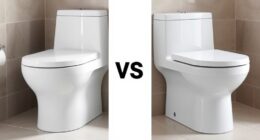Did you know that over 60% of homeowners with basements dream of having a functional toilet downstairs? If you’re one of them, you’re in luck!
In this step-by-step guide, I will show you how to install a toilet in your basement. From planning and preparation to connecting the toilet and testing for leaks, you’ll have all the information you need to successfully complete this project.
So let’s dive in and make your basement toilet dreams a reality!
Key Takeaways
- Assess the basement layout and consult with a professional plumber to determine the ideal location for the toilet installation.
- Consider factors such as proximity to existing plumbing lines, accessibility, and compliance with local building codes.
- Choose a toilet that fits well in the available space, considering size, water efficiency, and comfort.
- Gather the necessary tools and materials, including a high-quality wax ring, a flange that matches the drain pipe size, and the correct length of closet bolts with durable caps.
Planning and Preparation
Before you begin, it’s important to take the time to plan and prepare for installing a toilet in your basement. Start by assessing your basement layout to determine the best location for the toilet. Consider factors such as proximity to existing plumbing lines and accessibility.
Next, you’ll need to consider the plumbing considerations. Determine if your current plumbing system can handle the additional load or if you’ll need to install new pipes. Consult with a professional plumber if needed to ensure proper installation and compliance with local building codes.
Once you have a clear plan in place, you can move on to the next step of choosing the right toilet that will fit your basement layout and meet your specific needs.
Choosing the Right Toilet
When choosing the right toilet for your basement, it’s important to consider factors such as size, water efficiency, and comfort.
Firstly, determine the available space in your basement and choose a toilet that fits well without overcrowding the area.
Next, consider the water efficiency of the toilet. Look for models with a low gallon-per-flush rating to conserve water and reduce your water bill.
Additionally, think about the comfort level provided by the toilet seat options. You can choose between standard seats, soft-close seats, or even heated seats for added comfort.
Lastly, check the water pressure requirements of the toilet you are considering. Ensure that your basement plumbing system can provide the necessary water pressure for proper flushing.
Gathering the Necessary Tools and Materials
To gather the necessary tools and materials, you’ll want to make a list of items needed for the task at hand. Here are the essential tools and materials you’ll need for installing a toilet in your basement:
-
Toilet: Choose a toilet that fits your budget and meets your preferences. Consider factors such as water efficiency and comfort.
-
Wax Ring: This is a crucial component that creates a watertight seal between the toilet and the flange. Make sure to get a high-quality wax ring for optimal performance.
-
Toilet Flange: The flange connects the toilet to the plumbing system in the basement. It is essential to choose a flange that matches the size of the drain pipe and is compatible with the toilet.
-
Closet Bolts and Caps: These bolts secure the toilet to the floor. Ensure they are the correct length and have durable caps to cover them.
By gathering these tools and materials, you’re ready to move on to the next step of installing the toilet flange.
Next, I will guide you through the process of installing the toilet flange.
Installing the Toilet Flange
Once you’ve gathered the necessary tools and materials, it’s time to start installing the toilet flange. The toilet flange is an important component that connects the toilet to the floor and the sewer line. It ensures a secure and leak-free connection. Before you begin, it’s essential to be aware of common toilet flange problems and follow tips for a secure installation.
Common Toilet Flange Problems:
- Cracked or damaged flange: Inspect the flange for any cracks or damage. Replace it if necessary.
- Uneven or unlevel flange: Ensure that the flange is level and properly aligned with the floor.
Tips for a Secure Toilet Flange Installation:
- Use a wax ring: Place a wax ring on the flange to create a watertight seal.
- Use stainless steel flange bolts: Stainless steel bolts provide strength and durability.
- Tighten the bolts evenly: Alternate tightening the bolts to ensure an even and secure fit.
Connecting the Toilet and Testing for Leaks
After connecting the toilet to the flange, it’s important to test for leaks to ensure a proper installation. Here are four steps to troubleshoot common toilet installation issues and maintain a basement toilet system:
-
Check the water supply line: Make sure the supply line is securely connected to the shut-off valve and the toilet tank. Look for any signs of leakage or loose connections. Tighten any loose fittings if necessary.
-
Inspect the wax ring: The wax ring creates a watertight seal between the toilet flange and the base of the toilet. Ensure that it is properly aligned and centered. If there are any cracks or damage, replace the wax ring.
-
Flush and observe: Flush the toilet and observe if there are any leaks around the base or from the water supply line. If there are leaks, identify the source and tighten or replace the necessary components.
-
Conduct a dye test: Add a few drops of food coloring into the toilet tank. Wait for a few hours and check the bowl for any colored water. If there is, it indicates a leak, and you need to identify and fix the issue.
Frequently Asked Questions
How Do I Determine the Ideal Location for Installing a Toilet in My Basement?
To determine the ideal location for a basement toilet, consider accessibility and plumbing connections. Find a spot that is easily reachable and near existing plumbing lines. This will ensure a smooth installation process.
What Factors Should I Consider When Choosing a Toilet for My Basement Installation?
When selecting a toilet for basement installation, I consider factors such as the size of the space, plumbing requirements, and my personal preferences. It’s important to choose a toilet that fits well and meets all regulations.
Can I Use the Same Tools and Materials for Installing a Toilet in the Basement as I Would for a Regular Bathroom Installation?
Yes, you can use the same tools and materials for installing a toilet in the basement as you would for a regular bathroom installation. It’s important to consider the specific requirements of basement toilet installation.
Are There Any Specific Guidelines or Regulations I Need to Follow When Installing a Toilet Flange in the Basement?
When installing a toilet flange in the basement, it’s important to follow specific guidelines and regulations. These include ensuring proper positioning, using the correct materials, and adhering to local plumbing codes.
How Do I Troubleshoot and Fix Any Leaks That May Occur After Connecting the Toilet in the Basement?
To troubleshoot and fix leaks after connecting a toilet in the basement, start by checking the water supply line and connections. Tighten any loose fittings and replace damaged parts. Test the toilet by flushing and inspect for any further leaks.
Conclusion
In conclusion, installing a toilet in the basement is a straightforward process that can be accomplished with the right tools and materials. By carefully planning and choosing the right toilet, you can ensure a successful installation.
Remember to gather all the necessary tools and materials beforehand to streamline the process. Installing the toilet flange is a critical step that should not be overlooked.
Finally, connect the toilet and test for leaks to ensure proper functionality. Like a well-orchestrated dance, follow the steps and soon you’ll have a fully functional basement toilet.











